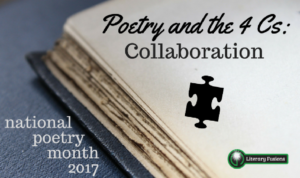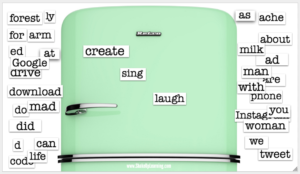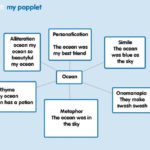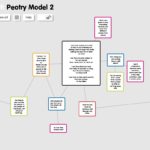 The ability to work in collaboration with others is a foundational skill for student success, both in the classroom and in their future endeavors. In order to collaborate successfully, students must learn to respect the opinions of others, take responsibility for their share of the project, and learn to compromise. The benefits of incorporating this into the study of poetry are astronomical! As students work together to understand and appreciate the poem they are studying, they are exposed to the interpretations and ideas of others. In a true collaboration, no one person completes the thinking. Rather, the involved parties reach a consensus based on the everyone’s input and interpretation of the text. This requires a higher level of thought and the exercise of many valuable soft skills, resulting in a deeper understanding for the students involved.
The ability to work in collaboration with others is a foundational skill for student success, both in the classroom and in their future endeavors. In order to collaborate successfully, students must learn to respect the opinions of others, take responsibility for their share of the project, and learn to compromise. The benefits of incorporating this into the study of poetry are astronomical! As students work together to understand and appreciate the poem they are studying, they are exposed to the interpretations and ideas of others. In a true collaboration, no one person completes the thinking. Rather, the involved parties reach a consensus based on the everyone’s input and interpretation of the text. This requires a higher level of thought and the exercise of many valuable soft skills, resulting in a deeper understanding for the students involved.
(Looking for the other 3 Cs? Communication and Critical Thinking, Creativity – check them out!)
The information age is almost synonymous with collaboration. With the internet at our fingertips, we crowdsource everything from answers to questions to funding projects to building databases of information – we need other people and their knowledge! Without collaboration, sites like Wikipedia and History Pin (seriously amazing site – check it out) wouldn’t exist!
Incorporating collaboration in today’s classrooms is almost non-negotiable if we want to prepare students for their future!
There are quite a few tools that allow for collaborative work, but here are a few of our favorites:
 Google Docs. Of course, Google tools top the list of tools that allow collaboration. Collaboration is one of the big things they are known for! Students can be logged in on their own devices and all contribute to one annotation of the same poem. They can leave comments out to the side with questions or thoughts to which others can respond in a kind of digital conversation. Up to 50 people can edit a Google Doc simultaneously – think of all the perspectives that could be gathered and absorbed from that many people! Check out our example here. Also, try collaborative magnetic poetry with Google Drawings!
Google Docs. Of course, Google tools top the list of tools that allow collaboration. Collaboration is one of the big things they are known for! Students can be logged in on their own devices and all contribute to one annotation of the same poem. They can leave comments out to the side with questions or thoughts to which others can respond in a kind of digital conversation. Up to 50 people can edit a Google Doc simultaneously – think of all the perspectives that could be gathered and absorbed from that many people! Check out our example here. Also, try collaborative magnetic poetry with Google Drawings!- VoiceThread. Another kind of digital conversation, this time around media. Uploaded in the middle of the screen could be a lyric video, could be an image, could be a picture of the text of a poem. Each student can contribute a note to the conversation that is represented by a little tile. They can type a response, but they can also record their voice. While they’re leaving their comment, they can annotate the media, and those annotations are attached to their comment. Students can listen to all the other comments that are left as well before they leave their own. Our example is linked here.
- Popplet. When using the online version of this simple tool, students can collaboratively brainstorm ideas onto the same canvas. By double-clicking on blank space, students get a popple into which they can type, draw, or add a picture. These popples can be linked together, and then rearranged as needed on the canvas, all the while maintaining the links between the ideas. This tool would be great to have students work together on an interpretation of a poem, or have students practice using poetic devices (see examples below). This link shows examples of how the student used Popplet to brainstorm before actually writing their own poem – so many possibilities.
- Collaborative Websites. There are many different options for this, including wikis (example) and (our favorite) Google Sites. These tools allow multiple authors to contribute to building a static website. With both wikis and Google Sites, permissions can at the individual page level to control what kind of access those authors have. This is a great way to have students present information in a variety of formats. From paragraphs to embedded video to hyperlinks, students can work together to create an informative website.
 Google Poetics. Google writes poetry based on popular searches! Start by typing something into Google and see what the autocorrect gives you. It’s amazing how poetic it can be! (Note: Not all of these are school appropriate.) http://www.googlepoetics.com/
Google Poetics. Google writes poetry based on popular searches! Start by typing something into Google and see what the autocorrect gives you. It’s amazing how poetic it can be! (Note: Not all of these are school appropriate.) http://www.googlepoetics.com/








Leave a Reply